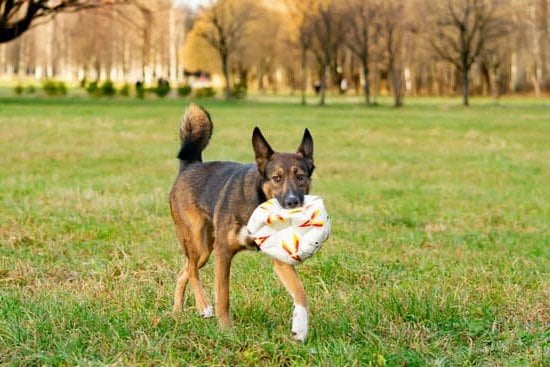Are you wondering how to train a dog to stop biting furniture? Many dog owners have experienced the frustration of coming home to find their beloved pets chewing on their furniture. In this article, we will explore the reasons behind this behavior and provide techniques for effectively training your dog to stop biting furniture.
Understanding why dogs bite furniture is crucial in addressing and correcting this behavior. There are various reasons why dogs engage in this destructive behavior, from teething and boredom to anxiety and lack of mental stimulation. By understanding the underlying causes, we can develop effective strategies to prevent furniture biting and encourage more appropriate behaviors in our furry friends.
In the following sections, we will delve into positive reinforcement techniques, redirecting attention, consistency in training, providing mental and physical stimulation, creating a dog-friendly environment, and seeking professional help when necessary. By implementing these strategies and understanding the role of teething and puppy training, you can effectively train your dog to stop biting furniture and create a harmonious living space for both you and your pet.
Positive Reinforcement Techniques
Understanding why dogs bite furniture is essential in addressing and preventing this behavior. It could be due to teething, boredom, anxiety, or lack of proper chew toys. By understanding the root cause, pet owners can better address the issue and implement appropriate training techniques.
Positive reinforcement is a highly effective method for training dogs to stop biting furniture. This technique involves rewarding good behavior with treats, praise, or toys to encourage the dog to repeat that behavior. When the dog displays appropriate chewing behavior on their own toys or designated items, it’s important to immediately reward them to reinforce the positive action.
To effectively train a dog to stop biting furniture using positive reinforcement, consistency plays a crucial role. Consistently rewarding the dog for choosing appropriate chew toys over furniture will help them understand what behavior is desired. Additionally, ignoring the dog when they engage in furniture biting and redirecting their attention towards an approved item will also reinforce positive habits.
In addition to positive reinforcement, it’s important to provide proper mental and physical stimulation for your dog. Regular playtime, exercise, and engaging activities will help prevent boredom and reduce the likelihood of furniture biting. It’s important to ensure that your dog has enough outlets for their energy so they are less likely to resort to destructive behaviors such as chewing on furniture.
Redirecting Attention
Dogs may bite furniture for various reasons, including teething, boredom, anxiety, or lack of proper training. Understanding the behavior is essential in addressing this issue and preventing further damage to your household items. It’s important to observe the circumstances surrounding your dog’s furniture biting, such as their age, environment, and daily routine. This understanding will help you implement effective training techniques to redirect their attention.
Positive reinforcement techniques are essential in training a dog to stop biting furniture. Using rewards such as treats or praise when your dog exhibits good behavior can help them associate positive actions with desirable outcomes. When implementing these techniques, consistency is key. It’s important to consistently reinforce and reward appropriate behavior while providing clear and firm correction when your dog attempts to bite furniture.
In addition to positive reinforcement, redirecting your dog’s attention towards more appropriate chew toys and activities is crucial in preventing furniture biting. Providing a variety of safe and durable chew toys can help fulfill your dog’s natural urge to chew while protecting your furniture. Engaging in regular playtime and exercise with your dog can also channel their energy into positive outlets, reducing the likelihood of them turning to furniture for entertainment.
It’s important to note that every dog is unique, and what works for one may not work for another. If you’re struggling with training a dog to stop biting furniture despite consistent efforts, it may be beneficial to seek assistance from a professional dog trainer or behaviorist. They can provide personalized guidance and support based on your dog’s specific needs and behaviors.
| Effective Techniques | Benefits |
|---|---|
| Positive Reinforcement | Associates good behavior with rewards |
| Redirecting Attention | Channels energy towards appropriate chew toys |
| Professional Assistance | Personalized guidance for challenging cases |
Consistency Is Key
Consistency in training is crucial when it comes to addressing and correcting a dog’s behavior, especially when it involves biting furniture. This section will explore why consistent training is important in preventing and stopping this unwanted behavior.
Setting Clear Boundaries
One of the key aspects of consistent training is setting clear boundaries for your dog. It’s essential to establish what behavior is acceptable and what is not, particularly when it comes to biting furniture. Dogs thrive on structure and routine, so it’s important to communicate clearly with them about what they are allowed to do in the home environment.
Regular Training Sessions
Consistency also means conducting regular training sessions with your dog. Whether it’s practicing commands, obedience training, or specifically addressing furniture biting, regular training sessions help reinforce positive behaviors and discourage negative ones. By consistently working with your dog, you can effectively communicate expectations and address any issues that arise.
Enforcing Consequences
Consistent training also involves enforcing consequences for undesirable behavior, such as biting furniture. When your dog engages in this behavior, it’s important to respond immediately and assertively, redirecting their attention towards appropriate chew toys or activities. By consistently reinforcing these consequences, your dog will learn that biting furniture leads to an unpleasant outcome.
By consistently setting boundaries, conducting regular training sessions, and enforcing consequences for unwanted behavior, you can effectively train your dog to stop biting furniture. It’s important to remember that consistency requires patience, dedication, and a clear understanding of how to train a dog to stop biting furniture.
Providing Mental and Physical Stimulation
Playtime and Exercise
One of the most effective ways to prevent boredom and reduce furniture biting in dogs is to ensure they receive plenty of playtime and exercise. Dogs that are not mentally and physically stimulated are more likely to engage in destructive behaviors such as furniture biting. Taking your dog for regular walks, providing interactive toys, and engaging in playtime activities can help keep them entertained and less likely to focus on chewing furniture.
Mental Challenges
In addition to physical exercise, mental stimulation is also crucial for preventing boredom and reducing furniture biting. Providing puzzle toys, hiding treats for your dog to find, and teaching new tricks can help keep their minds engaged and prevent destructive behaviors. By offering mental challenges, you can redirect your dog’s attention away from the furniture and towards more appropriate activities.
Training Techniques
Incorporating mental challenges into your training sessions can also be beneficial in preventing furniture biting. Teach your dog commands such as “leave it” or “drop it” to redirect their attention away from the furniture when they start to exhibit unwanted behavior. Use positive reinforcement techniques such as rewards and praise when they follow commands correctly. Consistency is key when using training techniques, so be patient and persistent in teaching your dog how to stop biting furniture.
By providing adequate playtime, exercise, mental challenges, and utilizing effective training techniques with positive reinforcement, you can significantly reduce your dog’s tendency to bite furniture. This approach not only helps prevent destructive behavior but also strengthens the bond between you and your canine companion.
Seeking Professional Help
When it comes to training a dog to stop biting furniture, some cases may require professional help from a dog trainer or behaviorist. While many pet owners can successfully address this behavior on their own, there are circumstances in which seeking guidance from a professional can be beneficial. Here are some instances when you may want to consider enlisting the help of a professional:
- If your dog’s furniture biting behavior is severe and causing damage to your home
- If you have tried multiple training techniques without success
- If your dog becomes aggressive when you try to intervene or redirect their attention away from furniture biting
Professional dog trainers and behaviorists have the expertise and experience to assess your dog’s behavior and develop a customized training plan to address the issue of furniture biting. They can provide valuable insights into the root cause of the behavior and offer effective strategies for modifying it.
Seeking professional help can also be beneficial if you are unsure of how to train your dog to stop biting furniture on your own. A qualified trainer or behaviorist can work with both you and your dog to implement a consistent training approach that fosters positive reinforcement and redirects your pet’s focus towards more appropriate chew toys and activities.
In addition, a professional can provide guidance on creating an enriching environment for your dog, including mental stimulation and exercise, which can play a significant role in preventing boredom-related furniture biting behaviors. Ultimately, seeking assistance from a professional can lead to a happier, healthier relationship between you and your beloved pet.
Creating a Dog-Friendly Environment
Dogs, like humans, need their own space where they feel comfortable and safe. Creating a dog-friendly environment within your home can help minimize the appeal of furniture as a chew toy.
One key tip for creating a dog-friendly living space is to designate a specific area for your dog that includes their bed, toys, and water bowl. This designated area can serve as your dog’s own space where they can relax and feel secure, reducing the likelihood of them seeking out furniture to chew on.
In addition to creating a designated area for your dog, it’s important to carefully choose the type of furniture and decor in your home. Opt for sturdy and durable materials that are less appealing for chewing, such as metal or wooden furniture.
Avoid delicate fabrics or materials that may easily become targets for your dog’s chewing habits. By making these mindful choices when selecting furniture and decor, you can help minimize the potential appeal of these items as chew toys for your canine companion.
Another helpful tip for creating a dog-friendly environment is to provide plenty of interactive toys and activities that are designed specifically for dogs. Interactive toys such as puzzle feeders, treat-dispensing toys, and chew toys can keep your dog engaged and mentally stimulated while also satisfying their natural urge to chew. By offering a variety of engaging options for your dog to enjoy, you can redirect their attention away from the furniture and towards more suitable alternatives.
By implementing these tips and creating a space that is specifically tailored to meet the needs of your canine companion, you can minimize the appeal of furniture as a chew toy in your home. Providing an inviting environment with designated areas, suitable furnishings, and plenty of engaging activities will help encourage positive behaviors in your dog while reducing the likelihood of destructive chewing habits.
If you’re interested in learning how to train a dog to stop biting furniture through creating a dog-friendly environment with proper layout then read on.
Understanding the Role of Teething and Puppy Training
In conclusion, training a dog to stop biting furniture requires patience, consistency, and understanding of your pet’s behavior. By understanding why dogs bite furniture and addressing the root causes, such as boredom or teething, pet owners can utilize positive reinforcement techniques and redirect their dog’s attention towards more appropriate chew toys. Consistency is key in enforcing boundaries and providing adequate mental and physical stimulation to prevent furniture biting.
It is important for dog owners to create a dog-friendly environment by minimizing the appeal of furniture as a chew toy and providing enough playtime, exercise, and mental challenges to prevent boredom. Seeking assistance from a professional dog trainer or behaviorist may also be necessary for severe furniture biting issues. Additionally, understanding the role of teething and early puppy training is crucial in preventing future furniture biting behaviors.
By incorporating these strategies into their training approach, pet owners can effectively address furniture biting behavior in their dogs. With time, patience, and consistent training, it is possible to modify this behavior and create a harmonious living space for both pets and their owners. Ultimately, with the right guidance and techniques, pet owners can successfully train their dogs to stop biting furniture.
Frequently Asked Questions
Why Does My Dog Start Biting Furniture?
Dogs may start biting furniture due to boredom, anxiety, or teething. It can also be a way for them to relieve stress or seek attention. Providing suitable chew toys and plenty of exercise can help address this behavior.
Do Dogs Grow Out of Chewing Furniture?
In most cases, dogs do grow out of chewing furniture as they mature and their teething phase ends. However, it’s important to train them and provide proper outlets for chewing during this phase to prevent it from becoming a long-term habit.
What Repels Dogs From Chewing Furniture?
There are several methods to repel dogs from chewing furniture, including using deterrent sprays with unpleasant tastes or smells, providing chew toys that are more appealing than furniture, and using positive reinforcement training techniques to redirect their chewing behavior. Consistency is key in addressing this issue effectively.

Welcome to the blog! I am a professional dog trainer and have been working with dogs for many years. In this blog, I will be discussing various topics related to dog training, including tips, tricks, and advice. I hope you find this information helpful and informative. Thanks for reading!





